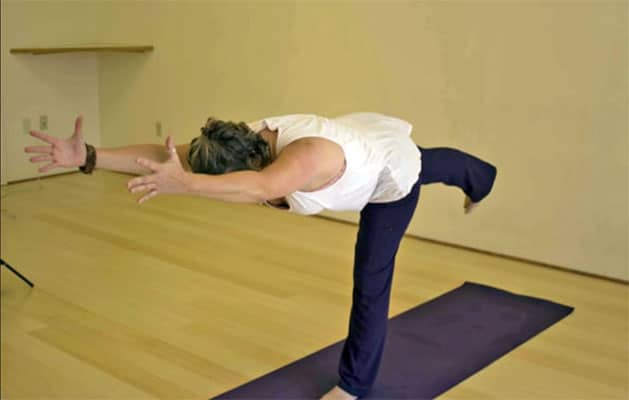 Warrior three pose. Courtesy photo
Warrior three pose. Courtesy photo
 By JACCI GRUNINGER
By JACCI GRUNINGER
MS, C-IAYT, ERYT500
There are many variations of the warrior poses in yoga but the main three are: Pars*va Vir*a*bha*drasana – Side Warrior; Vir*a*bha*drasana – Warrior and Vir*a*bha*drasana 3 – Balancing Warrior. The nice thing about all these poses is that everyone can be modified to suit your experience and ability in practice. You can even do all three of them with or on a chair.
These poses are great for strengthening the legs (especially the muscles around the knees), arms and core, as well as the ability to stay focused. Before diving into the actual techniques, here is a story about the warrior poses.
Mythological Story about the Warrior Poses
When Sati, the God Shiva’s first wife, shared with her parents her love of Shiva (Lord of the Universe) and desire to be married, they proceeded with the wedding plans and ceremony without ever meeting Shiva. It is important to note that Satis father, King Daksha had the job of overseeing and regulating rituals so that they were done correctly. The thought was that if you are going to invoke divine powers, do it right.
Shiva has many forms and arrived at his wedding in the form of the Lord of the Burial Ground – not a site a parent wants to see let alone know that he will be marrying their daughter. Sati, of course, was not deterred as she was familiar with all his forms. Her parents however, were distraught. At this, Shiva showed himself in all his grandeur and the parents were appeased but King Daksha held a grudge for this slight on his being.
Later, Lord Daksha decided to hold a grand party; a yagya or religious ceremony at his house. He did not invite his daughter or his son-in-law. Sati was beside herself with grief while Shiva opted to let it go and not make waves. He encouraged Sati to attend the party without him. Recall that King Daksha’s rule is to regulate ritual. However, at this ceremony, the only thing happening was the debasing of the wedding, his daughter and son-in-law. The King was only tooting his own horn and flaunting his wealth. Sati, in this distressed state, opted to offer herself as the sacrifice for the yagya and flung herself into the fire.
When Shiva heard what had happened he flew into a furious rage. He tore a hair from his head and threw it to the ground. Where the hair landed, a fierce warrior grew who personified all of Shiva’s emotions – anger, grief, vengeance. This warrior’s name was Virabhadra – a warrior to defend the innocent.
At first, with a salute to Shiva, Virabhadra returned to the palace and destroyed all those who participated in the sacrifice. He tore off Daksha’s head among other things. Sati was reborn as Parvati, this time with a father who supported Shiva and welcomed him into their family. Shiva did forgive Daksha and returned him to life but he had to live that life with the head of a goat.
The warrior poses are a progression and an opportunity to work with one’s own power and move with grace and control. If you can’t quite get into the full postures, take the modifications mentioned.
Stepping into the Warrior
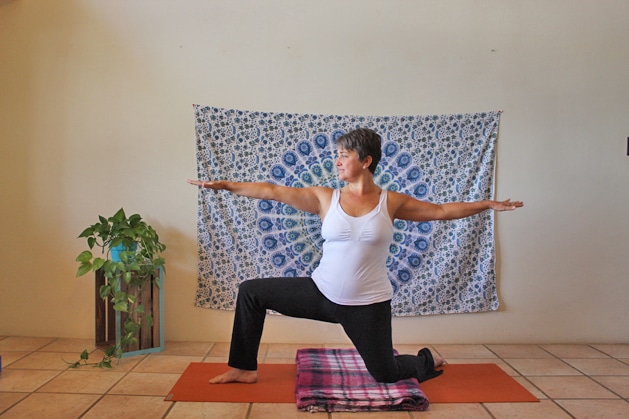
Side Warrior. Courtesy photo
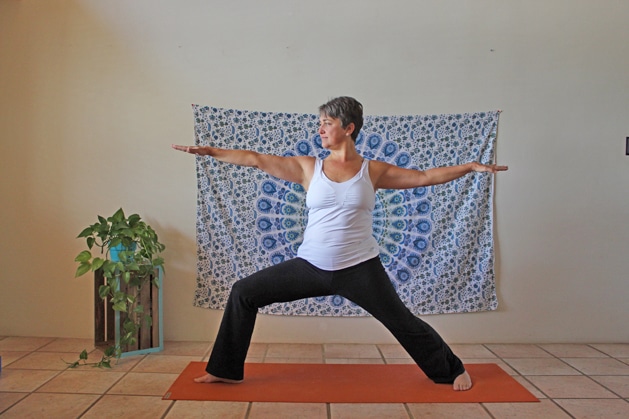
Side Warrior. Courtesy photo
Take a wide stance on your mat. Feel the support of the earth underneath your feet. Turn your right leg out ninety degrees and slide your left heel away so that the toes turn in. Keeping your hips and shoulders square to the long edge of your mat, bend your right knee to ninety degrees or as close as you can get keeping the knee over the ankle and toward the pinkie toe side of your foot. Inhale and raise your arms to shoulder height, spread your fingers to find space between the webbing. Root into your feet again as you draw your tailbone to the earth. Lengthen from pelvis to crown and then turn your head to look over your right middle finger. Feel the balance of reaching down and up with the body as well as forward and back with your arms and legs. Hold a soft gaze or close your eyes. Experience the power of the posture. Repeat on the other side. Try turning your palms up in a giving gesture on the second side. Can’t quite do the pose standing – try a shorter stance or come down into the kneeling version.
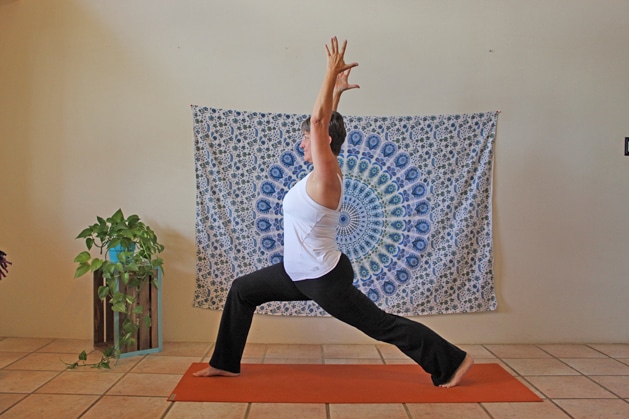
Warrior one pose. Courtesy photo
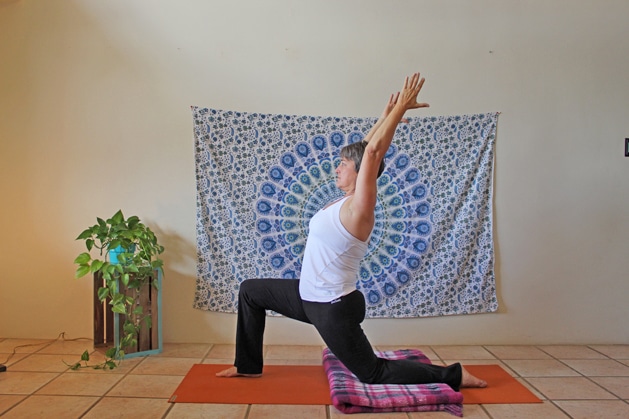
Warrior one pose. Courtesy photo
Stand at the top of your mat in Tadasana (mountain pose) with your feet one-to-two fist distance apart. As you exhale, step your right foot back into a high lunge. Stay on the back toes, feet in a railroad track stance, squaring your hips to the front edge of your mat. Keep your right knee over your ankle and sink your hips to the earth. Hold your gaze steadily forward and inhale your arms out to the side and overhead into a wide V. Draw your shoulder blades down your back and reach your tailbone toward the earth. Once more find the strength and power of reaching down and up, forward and back. To release, exhale and bring your hands to your front thigh, inhale and step forward. Release the body into a soft Tadasana to feel the posture. Repeat on the other side.

Warrior three pose. Courtesy photo
Here is where we truly move into the grace and control of the pose. From Warrior 1 bring your hands to shoulder height and take a small step forward with your back leg. Engage your abdominal wall and on an exhale straighten your front leg as you hinge forward bringing your torso parallel to the floor lifting your back leg to hip height. Reach through your fingertips and out through the heel of your lifted leg. Press down into the foot on the floor and reach through the crown of your head. Again, find the dynamic of up, down, forward and back. Keep your hips level as you soar. Play with reaching the arms overhead or if balance is an issue, use two blocks on your hands and work the torso/leg part of the posture. To release, inhale and lift to standing. Take a few moments to feel the grace of being and letting go. Repeat on the other side. You can also keep your hands on your hips, place them on a chair or counter or do a similar pose from table position with one leg up and the opposite arm up (extended cat or bird dog).
Jacci Gruninger is a Certified Yoga Therapist and Thai Yoga Massage Therapist. She has been teaching for 21 years and spent 12 of those years training yoga teachers for the Pranakriya School of Yoga Healing Arts. She regularly helps clients manage the ups and downs of life with yoga, meditation, breathwork and bodywork. You can practice yoga with her on Tuesdays 6:15-7:15pm and Sundays 6pm-7pm at Bethlehem Lutheran Church and Meditation with her Wednesdays, 6:30-7am & 7:15-7:45am at Revolt Coffee. Her office is at 190 Central Park Square #209.

